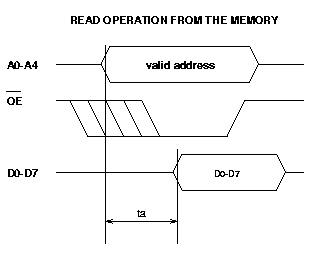
Storing data in some type of memory is a central role for many complex logic systems. In the previous labs we have seen that flip-flops can be used to store individual bits of data. A collection of flip-flops can be used to form a register that can hold a word of data containing certain number of bits.
The figure below represents a 32-Byte memory and each cell holds one bit of data. For this particular example, data can be accessed row by row (each row holds 8-Bits which is a Byte). That means one unique address points to 1-Byte of data. Once a particular row is addressed (between 0-31), 8-Bit data that lies at specified address will be available at the data output.

Since implementation of memories strictly depends on the demand, manufacturerers produce memories in most wanted sizes. Based on the problem requirements, a designer may use the most available memory in the market (and/or cheap) that satisfies the need. In the following figure, 32-Bytes of 32-KBytes were used.

The following figure shows timing diagram of some pins that involve in read operation for a memory.
